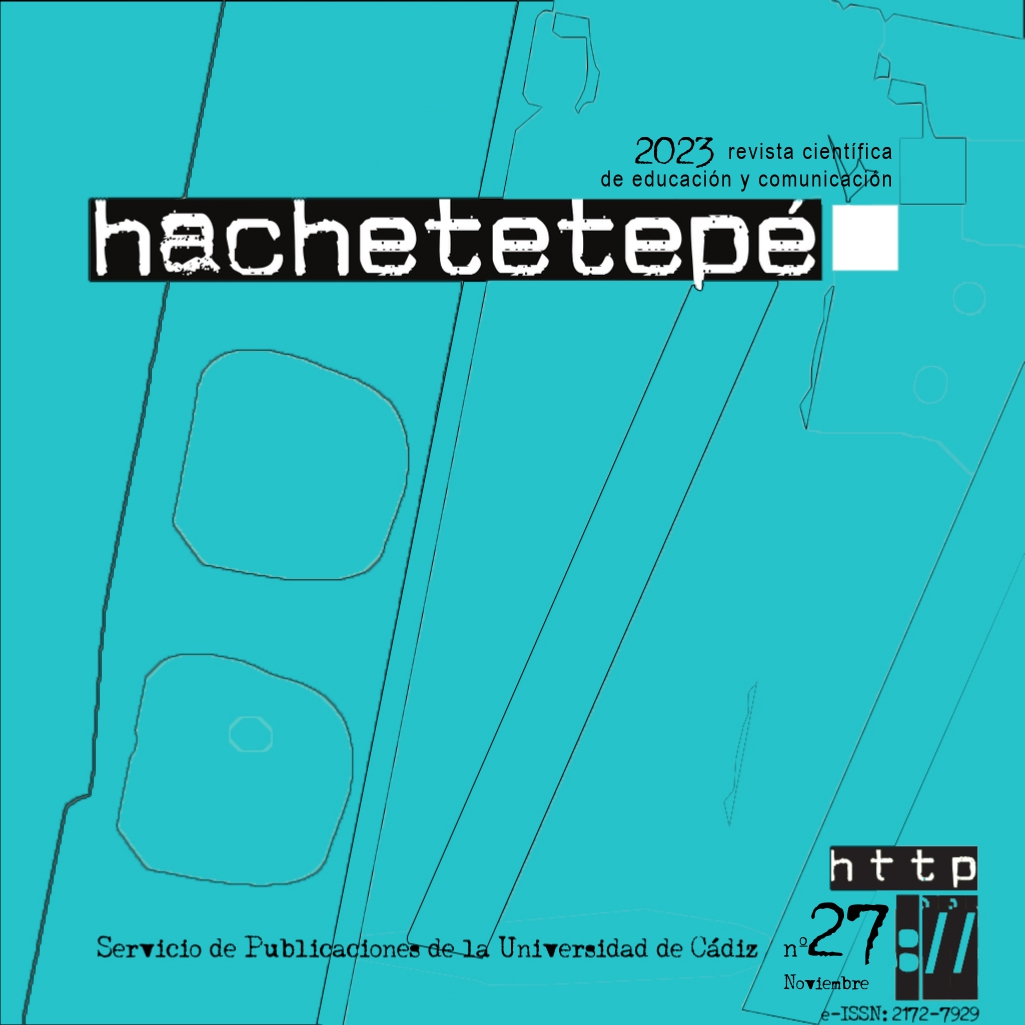Implementación de Retroalimentación Dinámica Correctiva en un ambiente de aprendizaje a distancia: lecciones y retos

Descargas
DOI
https://doi.org/10.25267/Hachetetepe.2023.i27.2204Información
Resumen
Este estudio es una investigación cualitativa del proceso de pensamiento de cuatro estudiantes en un programa de Ingles para Propósitos Académicos mientras participaban en Retroalimentación Dinámica Correctiva (Dynamic Written Corrective Feedback (DWCF) en inglés) dentro de un ambiente virtual sincronizado. El ambiente virtual incluyó el uso del sistema para el manejo del aprendizaje Canvas y el sistema Zoom de conferencia por video para la interacción de los participantes. También se utilizó Camtasia para capturar la imagen en las pantallas de computadoras (screencapture), Audacity, y Otter.ai para facilitar la colección de datos y preparación de transcripciones detalladas con informes verbales y acciones tomadas simultáneamente para el uso en análisis de data. Los resultados indican que generalmente los participantes implementaron actividades de DWCF ejecutadas dentro de este ambiente virtual, como fue demostrado por patrones generales en la data transcrita. Una discusión de lecciones aprendidas y desafíos para la implementación de DWCF sincronizado en línea es incluida.
Palabras clave
Descargas
Cómo citar
Licencia
Derechos de autor 2023 Christina Torres, Florin M. Mihai

Esta obra está bajo una licencia internacional Creative Commons Atribución-NoComercial-SinDerivadas 4.0.
Aquellos autores/as que tengan publicaciones con esta revista, aceptan los términos siguientes:
- Conservarán sus derechos de autor y garantizarán a la revista el derecho de primera publicación de su obra, el cual estará simultáneamente sujeto a la Licencia de reconocimiento de Creative Commons. Se pueden copiar, usar, difundir, transmitir y exponer públicamente, siempre que se cite la autoría, la url, y la revista, y no se usen para fines comerciales. No se permite hacer obras derivadas.
- Podrán adoptar otros acuerdos de licencia no exclusiva de distribución de la versión de la obra publicada (p. ej.: depositarla en un archivo telemático institucional o publicarla en un volumen monográfico) siempre que se indique la publicación inicial en esta revista.
- Difundir su obra a través de Internet (p. ej.: en archivos telemáticos institucionales o en su página web) una vez que el manuscrito sea aceptado, lo cual puede producir intercambios interesantes y aumentar las citas de la obra publicada. (Véase El efecto del acceso abierto)
Hachetetepé. Revista científica de educación y comunicación no cobra honorarios ni por la presentación de manuscritos ni por la publicación de sus artículos.
Citas
Berry, R. (2005). Making the most of metalanguage. Language Awareness, 14(1), 3-20.
Bitchener (2019) The intersection between SLA and feedback research. In K. Hyland & F. Hyland (Eds). Feedback in second language writing: Contexts and issues (2nd ed). (pp. 85-105). Cambridge University Press.
Bitchener, J., & Knoch, U. (2010). The contribution of written corrective feedback to language development: A ten-month investigation. Applied Linguistics, 31(2), 193-214.
Bowles, M. A. (2010). The Think-Aloud Controversy in Second Language Research. Routledge.
Chandler, J. (2003). The efficacy of various kinds of error feedback for improvement in the accuracy and fluency of L2 students writing. Journal of Second Language Writing, 12(3), 267-296. https://doi.org/10.1016/S1060-3743(03)00038-9
Eckstein, G., & Bell, L. (2021). Dynamic written corrective feedback in first-year composition: Accuracy and lexical and syntactic complexity. RELC Journal, 0(0). https://doi.org/10.1177/00336882211061624
Eckstein, G., Sims, M., & Rohm, L. (2020). Dynamic written corrective feedback among graduate students: The effects of feedback timing. TESL
Canada Journal, 37(2), 78-102. https://doi.org/10.18806/tesl.v37i2.1339
Ellis, R. (2009). A typology of written corrective feedback types. ELT Journal, 63(2), 97-107.
Ericsson, K. A., & Simon, H. A. (1993). Protocol analysis: Verbal reports as data. MIT Press.
Evans, N. W., Hartshorn, K. J., McCollum, R. M., & Wolfersberger, M. (2010). Contextualizing corrective feedback in second language writing pedagogy. Language Teaching Research, 14(4), 445-463.
Evans, N. W., Hartshorn, K. J., & Strong-Krause, D. (2011). The efficacy of dynamic written corrective feedback for university-matriculated ESL learners. System, 39(2), 229-239. https://doi.org/10.1016/j.system.2011.04.012
Ferris, D. (2011). Treatment of error in second language student writing (2nd ed.).University of Michigan Press.
Ferris, D. & Kurzer, K. (2019) Does error feedback help L2 writers? In K. Hyland & F. Hyland (Eds). Feedback in second language writing: Contexts and issues (2nd ed). (pp. 106-124). Cambridge University Press.
Ferris, D., & Roberts, B. (2001). Error feedback in L2 writing classes: How explicit does it need to be? Journal of Second Language Writing, 10(3), 161-184.
Hartshorn, K. J., Evans, N. W., Merrill, P. F., Sudweeks, R. R., Strong-Krause, D., & Anderson, N. J. (2010). Effects of dynamic corrective feedback on ESL writing accuracy. TESOL Quarterly, 44(1), 84-109. http://www.jstor.org/stable/27785071
Hartshorn, K. J., & Evans, N. W. (2012). The differential effects of comprehensive corrective feedback on L2 writing accuracy. Journal of Linguistics and Language Teaching, 3(2), 217–247.
Hartshorn, K. J., & Evans, N. W. (2015). The effects of dynamic written corrective feedback: A 30-Week Study. Journal of Response to Writing, 1(2), 6-34.
Kurzer, K. (2018a). Dynamic written corrective feedback in developmental multilingual writing classes. TESOL Quarterly, 52(1), 5-33.
https://doi.org/10.1002/tesq.366
Kurzer, K. (2018b). Student perceptions of dynamic written corrective feedback in developmental multilingual writing classes. Journal of Response to Writing, 4(2). 34–68.
Mayer, R. (2011) Applying the science of learning. Pearson
Mayer, R. E., & Moreno, R. (2003). Nine ways to reduce cognitive load in multimedia learning. Educational Psychologist, 38(1), 43-52. https://doi.org/10.1207/S15326985EP3801_6
McCabe, J.A., Banasik, C. S., Jackson, M. G., Postlethwait, E. M., Steitz, A., & Wenzel, A. R. (2023). Exploring perceptions of cognitive load and mental fatigue in pandemic-era zoom classes. Scholarship of Teaching and
Learning in Psychology. https://doi.org/10.1037/stl0000347
Swain, M., & Lapkin, S. (1995). Problems in output and the cognitive processes they generate: A step towards second language learning. Applied Linguistics, 16(3), 371-391. https://doi.org/10.1093/applin/16.3.371
Truscott, J. (1996). The case against grammar correction in L2 writing classes. Language Learning, 46(2), 327-369.
Truscott, J. (2007). The effect of error correction on learners' ability to write accurately. Journal of Second Language Writing, 16(4), 255-272. https://doi.org/10.1016/j.jslw.2007.06.003






